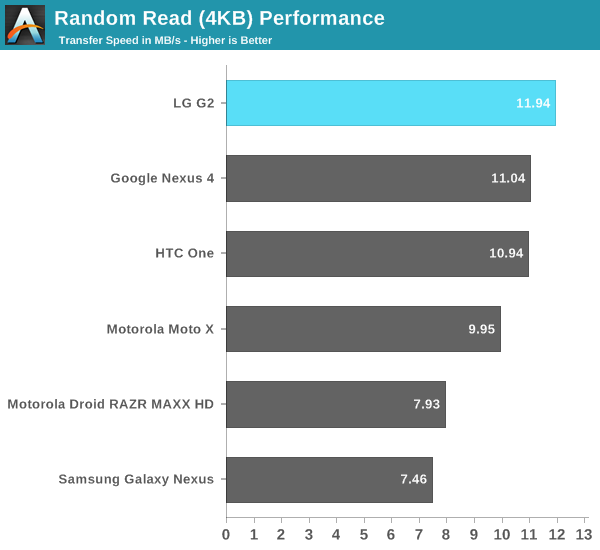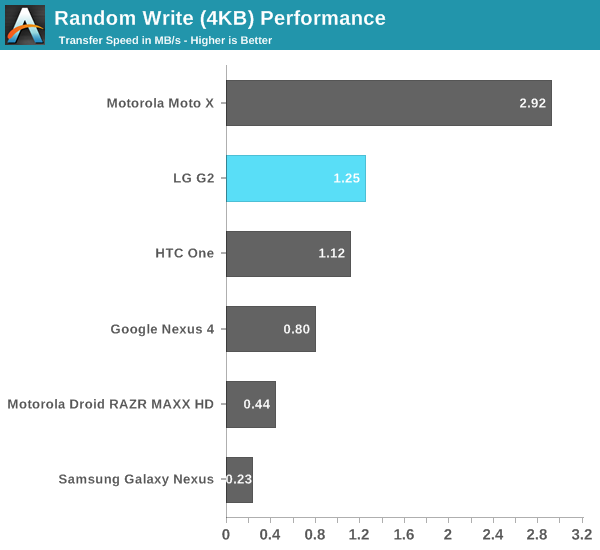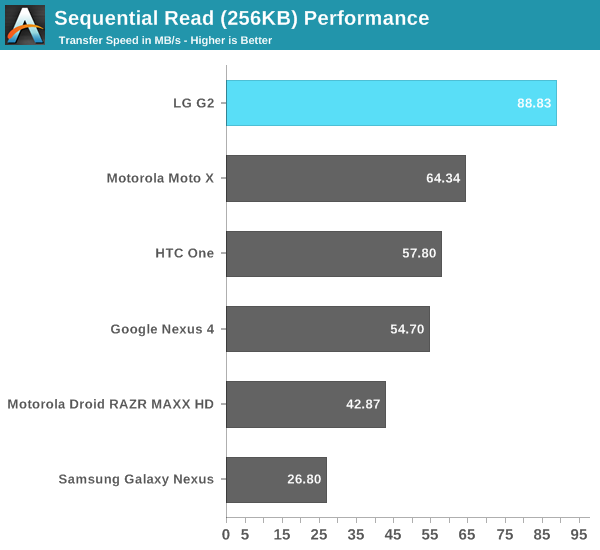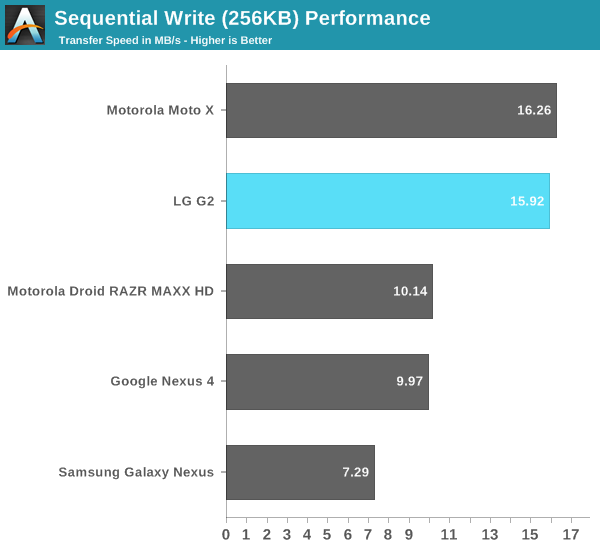LG G2 and MSM8974 Snapdragon 800 - Mini Review
by Brian Klug on September 7, 2013 1:11 AM EST- Posted in
- Smartphones
- LG
- Mobile
- LG G2
- Android 4.2
- MSM8974
- Snapdragon 800
NAND Performance
The G2's NAND performance is relatively decent in random read and sequential read/write tests. Sequential read performance in particular is extremely good for a smartphone. Unfortunately random write performance is nothing special, and can't hold a candle to the Moto X thanks to Motorola's use of F2FS instead of ext4 for the user data partition.














120 Comments
View All Comments
ijozic - Saturday, September 7, 2013 - link
Would love to see some audio quality tests and a comment on the volume levels (maybe in the full review?) as LG usually goes below average in this area..Impulses - Saturday, September 7, 2013 - link
SecondedBoneAT - Saturday, September 7, 2013 - link
It's interesting that the G2 either slightly over-exposes most situations, or the dynamic range is tighter than on the S4 Octa's Exmor RS and or the Lumia 1020, this applies to photos and videos alike. Otherwise I'm highly impressed with the camera performance, very natural, even slightly under-saturated results like the S4 Octa (which in the 808 comparison shows that it's everybody else over-saturating), I'd only set half a step lower exposition correction and let everything else done by the device.Brian, what is the maximum exposure time you could get automatically or manually off a single shot? What is the highest ISO value?
Jon Tseng - Saturday, September 7, 2013 - link
Hmmm. So looks like trade off vs Nexus 5 (2300mah) will be great battery life vs OS updates. Tough one!On rear buttons I'm cool w that -used to have atrix w rear power button/fingerprint and no probs at all w day to day use.
andykins - Saturday, September 7, 2013 - link
Don't forget the biggest difference (imo): price. The Nexus 5 should be around half the price.Alketi - Saturday, September 7, 2013 - link
This actually bodes *very* well for the Nexus 5, as it also packs a Snapdragon 800 chipset.It's not too much of a stretch to expect better battery life than the Nexus 4, which was already decent. Plus, there's a good chance of an upside surprise, if it also packs the panel self-refresh and gets gains from Android 4.4.
Spunjji - Monday, September 9, 2013 - link
One thing worth bearing in mind is that even with ~75% of the battery capacity the G2 would still have class-leading battery life. So, the Nexus 5 is hardly going to stink in that regard!Krysto - Saturday, September 7, 2013 - link
Great to see those battery efficiency improvements from Qualcomm. You'd following the right path here, Qualcomm. Please don't change.Nvidia is stupid for following the "pure performance" path. That strategy has lost them most customers, especially since they followed that strategy to the point where they were making only "tablet chips", which is code-word for "our chips aren't efficient enough for smartphones".
I've said it before, chip makers should think about making "smartphone chips" first and foremost, and THEN, use the same chips, maybe with a little extra clock speed in tablets, too. If think think about making "tablet chips", they will blow it, because they will make the chip too inefficient and won't be able to "downscale" as easily to put it in smartphones.
So yeah, Qualcomm please continue doing your own thing. If Nvidia, Samsung and others keep following the "performance/benchmark" path, then the joke is on them, and will ultimately fail (as they have so far, and it's most devices are using Qualcomm's chips). I do hope they wake up to it sooner rather than later though, because I don't want Qualcomm to become another monopolistic Intel.
UpSpin - Saturday, September 7, 2013 - link
Qualcomm is the only Android SoC producer which does design their own cores and does not rely on ARM finished CPU designs.If you take a close look, you'll see that the Tegra 4 and the Exyons 5 are the only A15 processors at the moment, and it probably took much longer for ARM to release them and for NVIDIA and Samsung to finalize them than expected. They also had no other option than A15 to get some improvement over A9 and to remain competive with future Qualcomm SoCs.
Qualcomm on the other hand was able to release minor updates the whole time, so processors between A9 and A15.
Samsung will do the same next year, so expect some larger competition to Qualcomm.
Qualcomm also has the big radio advantage, which NVIDIA adressed with the i500 and which might make them competive to Qualcomm next year again.
Neither Samsung nor NVIDIA followed a performance strategy only. They had no other choice than using A15, and Tegra, as always used their 4+1, Samsung had to use big.LITTLE to make A15 usable in a smartphone. But big.LITTLE wasn't fully ready yet, so they had no other choice than using an octa-core setup.
And also remember that MIPS (a competive contender to ARM, but so far mostly used in low end applications) got bought up by Imagination Technologies, which I strongly believe will try everything they can to push MIPS in the high end sector.
So I think it's safe to assume that there won't be a monopoly, Qualcomm just had a big advantage for one year because of the A9 to A15 gap and by offering integrated radios. Both Samsung and NVIDIA learned from this, and a new competitior to ARM is coming up, too.
So it will get really interesting.
Impulses - Saturday, September 7, 2013 - link
That one year advantage in design turned into two solid years of device wins for Qualcomm tho... It's gonna get interesting next year for sure.